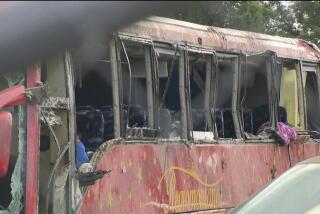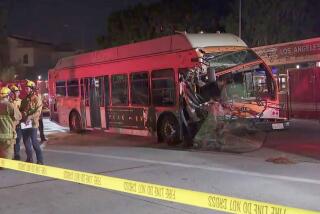Safety Board Blames Driver for Tour Bus Crash
- Share via
WASHINGTON — The National Transportation Safety Board said Tuesday that a bus driver’s failure to slow down on a dangerous mountain curve probably caused the charter bus crash near Walker, Calif., last May 30 that killed 21 elderly Southern Californians.
The board also said inadequate screening and supervision of the driver by the tour bus operator, Starline Sightseeing Tours Co. of Hollywood, contributed to the accident. The board said Starline should never have hired the driver, Ernst A. Klimeck, 48, because of his poor driving record, which includes eight speeding citations since 1981--two of them in Starline buses.
Klimeck faces felony manslaughter charges arising from the crash, in which the tour bus careened out of control through a torturous “S” curve and plunged into the Walker River in the eastern Sierra. The bus had been returning from a four-day tour of Las Vegas, Lake Tahoe and Reno. In addition to those killed, another 20 passengers were injured.
Klimeck has pleaded not guilty to the charges and has told investigators that he heard a loud “plop” from the rear of the bus just before the accident. The safety board said Tuesday that its investigation found no evidence of a mechanical problem on the bus but added that it could not rule out the possibility that equipment failure contributed to the wreck.
Starline attorney Terence Lyons disputed the board’s findings: “I don’t believe that the screening and supervision of this driver contributed to this accident. And I don’t believe there was anything inadequate in screening of the driver.”
Lyons said the bus company has tightened its standards for drivers since the accident so that someone with Klimeck’s record would not be hired. “But that is not to say the policy that was in effect before the accident was the cause of the accident,” Lyons insisted.
Safety board Chairman Jim Burnett said the tragedy dramatizes the “unacceptable” level of oversight of the commercial trucking and bus industries in the United States. He said his board will issue recommendations soon for strengthening the inspection, regulation and screening of drivers and equipment of commercial highway carriers nationwide.
“We have known for a long time that we do not have a good system for detecting poor drivers in this country and this accident points up many of those flaws,” Burnett said. “It reiterates the need to deal with commercial driver qualification.”
He said the Transportation Department’s Office of Motor Carrier Safety, charged with enforcing federal safety rules for interstate trucking and bus firms, is “severely undermanned.” The office has 300 inspectors to oversee nearly 200,000 carriers, allowing less than one four-hour inspection visit a year to each carrier.
Starline had received such an inspection three years before the fatal wreck and was cited for “unsatisfactory” maintenance and record keeping, the safety board staff said Tuesday. However, no action was taken.
Federal transportation officials conducted a follow-up visit two years later and lifted the unsatisfactory rating. Burnett said Tuesday that the inspectors missed many violations because “they did not do an adequate job.”
Safety board member Patricia A. Goldman said the case demonstrates that the current system of regulating motor carriers is seriously flawed. “How bad do you have to be before some action is taken? Starline got an unsatisfactory rating, but it didn’t mean a doggone thing in terms of their future operation,” she said.
The board also called for a national standard for commercial driver performance, requiring that drivers’ licenses be lifted if they accumulate a given number of traffic violations within a set period, as most states do for private motorists. In 1981, the board recommended that three violations in three years be the standard, but the rule has been blocked by vigorous opposition from the trucking lobby, Burnett said.
The board’s conclusion about the cause of the Starline crash matches that of the California Highway Patrol, which conducted its own four-month investigation. “Speed was the only cause of this accident,” CHP Deputy Chief Leonard DeGroff said in September.
State and federal investigators estimated that Klimeck was going between 65 and 68 m.p.h.--nearly the bus’ top speed--as he went south on U.S. 395 in Mono County about 20 miles north of Bridgeport.
At that point, the two-lane highway snakes through a narrow gorge in a series of “S” curves that parallel the Walker River. A yellow caution sign warns motorists that the maximum safe speed is 40 m.p.h.
More to Read
Sign up for Essential California
The most important California stories and recommendations in your inbox every morning.
You may occasionally receive promotional content from the Los Angeles Times.










